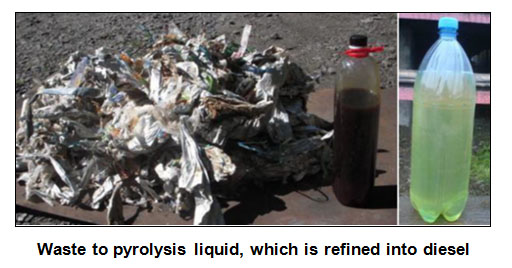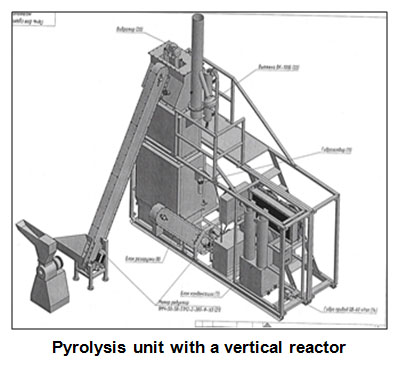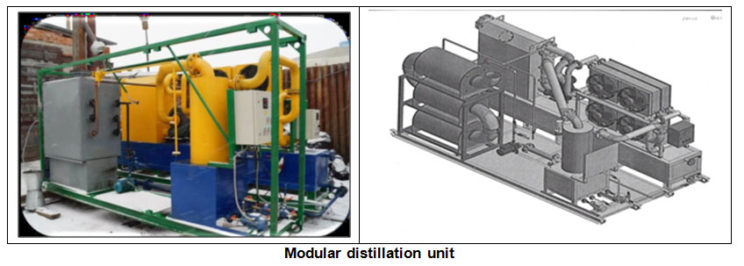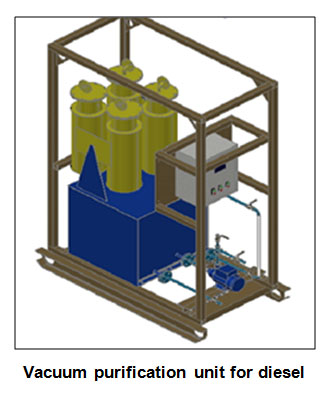Bio-refinery for the conversion of wood waste / agricultural residues + oil waste into clean & renewable diesel by pyrolysis, distillation & purification
GoodRich offers from Russia, a new way of converting solid hydrocarbons into liquid hydrocarbons by pyrolysis. A design house consisting of petro-chemical scientists & engineers in Russia developed a technology for the conversion of liquid oil wastes (used engine oil, used motor oil, oil sludge, coal tar, tyre pyrolysis oil, etc.) into Euro-4 diesel. Such plants are successfully running in Kazakhstan, Vietnam & China.
Recently, the same design house has developed a revolutionary technology to convert any biomass / wood waste + oil waste into clean & renewable diesel, with low sulphur levels of 0.02%.

2. The process & the equipments –
The modular bio-refinery plants from Russia can convert any solid + liquid wastes into synthetic liquid fuels. Such plants can be placed in 40 ft. containers, and they do not need any foundation. They consist of the following equipments –
a) Pyrolysis unit – The pyrolysis unit is universal with regards to raw materials. It can use 50% wood waste / saw dust /agricultural waste etc., along with 50% motor oil waste / oil sludge / any other oily waste. Even the RDF (Refuse-Derived Fuel) from the municipal waste can be used, after shredding into small pieces of less than 5 cm size.
The output of the pyrolysis unit is light oil, gas & carbon. While the gas is used for process requirements, the carbon is sold & the light oil is converted into diesel. The moisture content of the wood waste should be less than 20%; otherwise the process becomes slow. A special vacuum pump is provided in the pyrolysis unit to take away the water during the process.
Any synthetic oil, mineral oil or waste cooking oil is acceptable to mix with the biomass. In Belgorod city of Russia, high quality diesel is being made from the cooking oil waste.
The oil wastes include engine oil waste, gearbox oil waste, tyre pyrolysis oil, cracking oil, furnace oil, mazut, etc. The solid wastes include paper waste, coconut husk, wood waste & all other biomass sources. Experiments with the operation of the plant showed that woody biomass is the best catalyst.

b) Distillation unit – The atmospheric distillation unit evaporates & condenses the light oil into petrol (at 40-200°C), Kerosene (at 140-300°C) & diesel (at 280-350°C). Any two products can be made at a time. The petrol corresponds to GOST AL-80, while the diesel corresponds to GOST 305 – 82 / Euro-4 Standards. The yield of diesel is 80-85%, while the yield of kerosene + petrol is 10-15%.
Distillation is the separation of liquids into fractions, which have different composition. It is carried out by partial evaporation of the liquid & further by vapour condensation.
 c) Vacuum purification unit – The vacuum purification unit has 4 vacuum chambers to clean the diesel thoroughly. The purification unit removes the residual moisture, improves the colour &cetane number of the diesel and also reduces its sulphur contents. The purification unit needs absorbents, which can be purchased locally.
c) Vacuum purification unit – The vacuum purification unit has 4 vacuum chambers to clean the diesel thoroughly. The purification unit removes the residual moisture, improves the colour &cetane number of the diesel and also reduces its sulphur contents. The purification unit needs absorbents, which can be purchased locally.

3. Pyrolysis of solid biomass –
Pyrolysis is the decomposition of organic materials. It is the thermal cracking of any compounds in the absence of oxygen into lighter molecules under the influence of increasing temperature.
The yield of pyrolysis liquid is 90-96% of the hydro-carbon portion of the raw material mix. For example, if the agricultural waste has 40% carbon & 5% hydrogen & if the oil waste has 90% hydrocarbons, after pyrolysing a 50:50 mix of the above raw materials, the yield of liquid oil is 60-65% of the dry weight of the raw material.
The wood / biomass residues have lower hydro-carbons. They have large groups of alcohols, which are more volatile & light- boiling. They do not have any sulphur compounds. They are the best catalysts for synthesis of the petroleum products. On the other hand, used oils / oil wastes have heavy hydro-carbons, which are less volatile with higher boiling fractions & higher contents of sulphur compounds. Hence, by mixing of these two types of wastes in the ratio of 1:1, we get an ideal raw material mixture for further processing.
The mixing of these two wastes has positive effects during the thermal degradation & activation of energy. It causes a multi-fold increase in the efficiency of waste processing unit & as a result, more oil & less gas are formed. For example, from 100 kgs of mixed solid waste, 60 kgs of pyrolysis liquids can be produced & after distillation of the same, 50 kgs of Euro-4 quality of diesel can be produced.

While converting 100 kgs of biomass into pyrolysis liquids, around 15 cubic metres of associated gas is formed, which is used for own production needs. The heat value of the gas is about 2,800 kcal/kg. The generation of ash is about 5%. While converting 60 kgs of pyrolysis liquids into 50 kgs of diesel, 4-5 kgs of residual oil is formed, which is subsequently mixed with the biomass, as a partial replacement for waste oil. Hence, the process is auto-regulated, without generating any other waste products.
The land requirement is about 3,000 sq.ft. The power requirement is 12-15 KWh, including the power for the shredder. Only 2 workers are needed for the operation of the plant.
There is no water requirement for the process. Air is used for cooling. For burner also, a small quantity of compressed air is needed.
The delivery period for the equipments is 90 days & the shipping time is 45 days. The assembly, erection & commissioning takes 15 days, with 3 Engineers from Russia.
The project is economically viable, with a pay-back period of less than 2 years.
